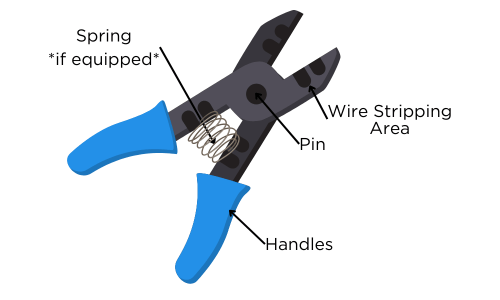Wire Stripper
Anatomy of a Wire Stripper

What is a Wire Stripper?
Who would use a Wire Stripper?
Wire strippers are commonly used by:
1. Electricians: For wiring installations, repairs, and electrical maintenance work.
2. Electronics Technicians: In assembling, repairing, and modifying electronic devices and circuit boards.
3. DIY Enthusiasts: For home electrical projects, like installing lights or outlets.
4. Telecommunications Technicians: When working with phone and data cables.
5. Automotive Technicians: For repairing and installing electrical systems in vehicles.
6. HVAC Technicians: In wiring heating, ventilation, and air conditioning systems.
7. Audio/Video Installers: For setting up sound systems, home theaters, and other A/V equipment.
8. Maintenance Workers: For general repair tasks involving electrical wiring in buildings and facilities.
9. Hobbyists: In crafting and robotics, where electrical wiring is involved.
10. Students: Particularly those studying electrical engineering, electronics, or related fields, for practical work and projects.
To Spring - Or Not to Spring?
Choosing a wire stripper with or without a spring depends on the user’s preference and the nature of the work:
With a Spring:
- Ease of Use: The spring automatically opens the jaws after each cut, reducing hand fatigue, which is especially useful for repetitive stripping tasks.
- Speed: It can increase the speed of work, as it allows for quicker movement from one wire to the next.
- One-Handed Operation: It facilitates one-handed operation, leaving the other hand free to hold the wire or another tool.
Without a Spring:
- Control: Some users prefer the manual control of opening and closing the jaws for more precise work or when working in tight spaces where the spring action might be cumbersome.
- Simplicity and Durability: Without a spring, the tool has fewer moving parts, which might increase its durability and reduce the risk of malfunction.
- Preference and Habit: Some professionals are accustomed to non-spring models and prefer them for their tactile feedback and traditional operation.
Ultimately, the choice between a spring-loaded or a traditional wire stripper comes down to personal preference, the specific requirements of the task at hand, and what feels more comfortable and efficient for the user.
Safety Precautions with Wire Strippers!
ToolFinder Recommends

IRWIN VISE-GRIP Wire Stripping Tool / Wire Cutter, 8 inch, Cuts 10-22 AWG, ProTouch Grip (2078309)
For a standard springless wire stripper, check out this IRWIN VISE-GRIP Wire Stripping Tool / Wire Cutter, 8 inch, Cuts 10-22 AWG, ProTouch Grip (2078309)

Klein Tools 11055 Wire Cutter and Wire Stripper, Stranded Wire Cutter, Solid Wire Cutter, Cuts Copper Wire
If you’re looking for a smaller springed wire stripper, that doesn’t have features like bolt cutting built-in but can fit in a tighter space – check out this Klein Tools 11055 Wirehttps://m.media-amazon.com/images/I/61Svsk9jkaL._AC_SL1500_.jpg Cutter and Wire Stripper, Stranded Wire Cutter, Solid Wire Cutter, Cuts Copper Wire

IRWIN VISE-GRIP Wire Stripper, 2 inch Jaw, Cuts 10-24 AWG, ProTouch Grip for Maximum Comfort (2078300)
If you can spend a little bit more and do a fair amount of wire stripping, an automatically self-adjusting mechanism style stripper may be be for you. For such a wire stripper, check out the IRWIN VISE-GRIP Wire Stripper, 2 inch Jaw, Cuts 10-24 AWG, ProTouch Grip for Maximum Comfort (2078300)